► CAR’s editor in chief reviews IAA 2017
► Fresh ideas, electrification – and no-shows
► Hits, misses, trends, themes and surprises
From Merc’s F1-engined hypercar to an EV hatchback, a 592hp M5 to a new BMW i car, a steering wheel-less Audi to the latest RS4 Avant, the Frankfurt show epitomised the dichotomy facing car makers. What to do in the face of the onslaught of environmentally sensitive policy makers and circling tech firms but slowly changing consumer habits?
Keep calm and cover all bases.
The car makers did this with gusto, making Frankfurt 2017 a pretty joyous and encouraging jamboree, full of fresh ideas, where performance junkies and politicians alike could find cars to champion.
You can watch CAR’s Phil McNamara, Tim Pollard and Ben Miller review the show, direct from one of its exhibits(!) in the video above.
Click here for CAR’s full A-Z guide to all the new cars at IAA 2017

Mercedes-AMG’s show-stopping hypercar
I can’t help but start with the AMG Project One, Mercedes’ performance arm’s 50th birthday present to itself and a few hundred lucky customers.
Lewis Hamilton proved himself a good sport by driving the €2.275m hybrid hypercar into the limelight at two different Frankfurt previews.
Behind his two-seat driver cell is mounted the F1 team’s 1.6-litre turbo V6, claimed to spin beyond 11,000rpm, idle calmly in traffic and not need servicing for 30,000 miles. Quite a feat.
With its battery electric boost from three motors, the Project One summons in excess of 1000bhp and surpasses 217mph. Not many people were sold on its looks though, with a generic front end that sacrifices beauty for functionality.
The understated form of the EQA electric concept (below) – a Focus-sized hatch, pictured below – beside it only accentuated the Project One’s ferocity.
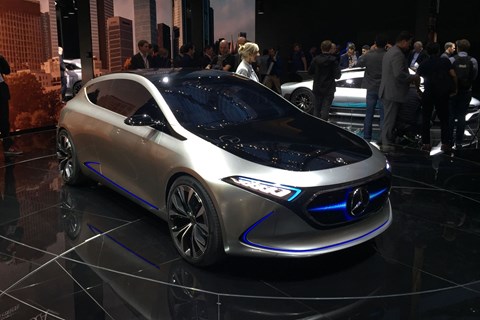
Has dieselgate accelerated the demise of derv?
At Frankfurt 2015, Volkswagen was on the brink of being engulfed by dieselgate. Two years on, executives across the show floor fielded questions about the impending demise of diesel. Seat’s Luca de Meo provided a typically rounded response: the efficiency of compression ignition plays a role in suppressing carbon emissions and some European markets – shaped by fiscal policy – are wedded to derv.
On the flipside, engineering the stepchange to the next Euro emission standard will prove a technical and cost challenge, and consumers appear to be voting with their feet. So Seat – like all car makers – must forge ahead with EVs.

The Spaniards are formulating their take on the Volkswagen Group’s MEB electric components set, to deliver a production car for 2020. Volkswagen itself showcased three of its upcoming EV family – the ID hatch, ID Buzz kombi van, and ID Cross(over), as chairman Matthias Mueller (above) confirmed all Volkswagen models would be electrified from 2030 with either EV or plug-in variants.
But conversations often strayed towards the challenges of EVs: the lack of a charging infrastructure (both public and domestic) and the bigger issue of clean grid generation.
The message was clear: if governments have decided electric cars are the answer, then they need to help make this solution work – Opel’s new boss (and PSA’s old boss) Carlos Tavares was particularly strident on this.
2017 – a year of no-shows
The Germans dominated their home show, but with the caveat that many import brands decided to stay away rather than take them on. Volvo and Aston Martin’s non-appearance is nothing new (though CEO Andy Palmer held court at a nearby hotel before we spotted him checking out Bentley’s new Continental GT), but Nissan, Peugeot, DS, Fiat, Jeep, Alfa Romeo, Mitsubishi and Infiniti’s no-shows must have shocked the organisers. Welcome to the new normal, where car makers opt for more glamorous experiential events such as Goodwood or Pebble Beach, or bank the marketing bucks for other purposes.
Frankfurt sick notes: why so many manufacturers were a no-show at IAA 2017
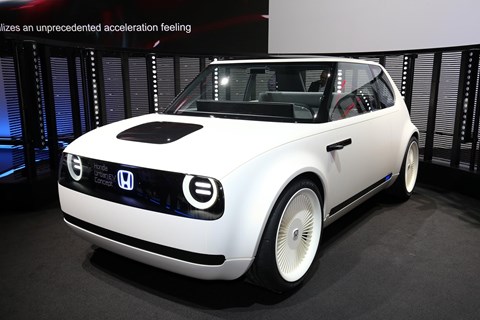
Honda’s retro charmer
Honda, a brand that’s really been in the doldrums, stood out among the import brands. Its stocky, retro EV city car concept received a widespread press day thumbs up, and there was a novel tech showcase too: a petrol/electric hybrid without a conventional transmission.
Bound for the new CR-V when it launches in Europe in late 2018, the i-MMD (Intelligent Multi Mode Drive) has a 2.0-litre Atkinson cycle engine which typically acts as a range extender to power the hybrid system, though a single fixed gear ratio can deliver direct petrol drive to the front axle under heavier load.
Honda claims the compact and light system significantly reduces friction losses and boosts efficiency, but no mpg figures until the drivetrain is homologated.
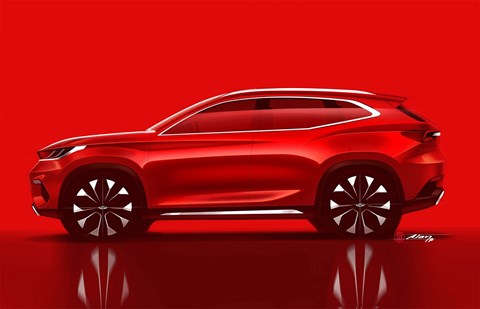
China’s automotive industry continues to accelerate
Another Asian novelty was a smattering of Chinese brands. Great Wall, recently linked with a buyout of Fiat Auto, showcased its Wey brand, ‘the premium SUV pioneer’. Pioneering of an unprecedented caveat on every production car – a sign saying ‘this vehicle is currently not for sale in Europe’ – but spokespeople said exports would commence in a couple of years.
Chery VP boss Ray Bierzynski, a 35-year stalwart of GM parish, was even less emphatic about when the Chinese car maker would expand west from its Russian market foothold. The Frankfurt 2017 showing was all about showing intent (and the concept car sketched above), he said, and reassuring consumers here that the cars would meet European safety and quality standards.
Timings may be vague, but the Chinese are coming – which will open up another front for mainstream car brands already fighting the premium push downwards.
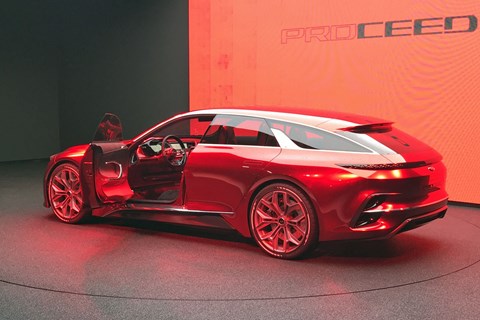
Kia’s style statement
Before the millennium, Korean car makers were viewed as the equivalent of today’s Chinese brands. But at Frankfurt, Kia kept up its momentum (it claims to be the only brand to have posted European volume growth every year since the financial crash) with the Proceed shooting brake concept.
The new Ceed arrives next year, lower, wider and with better proportions if this preview reflects the production car.
Design chief Gregory Guillaume fondly recalled the three-door Proceed being his first design for Kia – but added that with three-door hatch sales declining, this concept was exploring where the brand might go instead.
Smart money is on the Proceed shooting brake becoming a slightly higher priced variant in the new Ceed family.
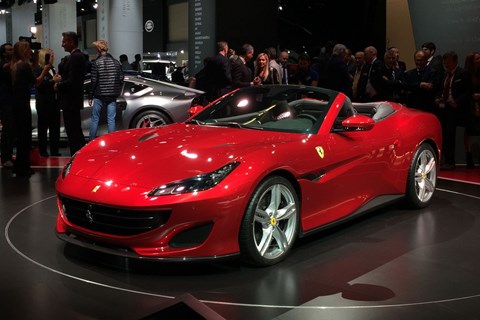
Changing times at Maranello
It wasn’t a show overwhelmed with supercars: aside from the Project One, Lamborghini chopped the top off the latest Aventador S and Audi showed its rear-wheel drive R8.
Ferrari unveiled the Portofino (above), the replacement for the California T. Tougher-looking, more rigid and with the stiffer suspension from the California T ‘Handling Speciale’ version, the Portofino should prove a far sharper drive.
One telling footnote: Ferrari has now shown two all-new series production cars in the space of seven months. It appears new model introductions are ramping up now that the Prancing Horse is a standalone luxury brand with investors to satisfy.
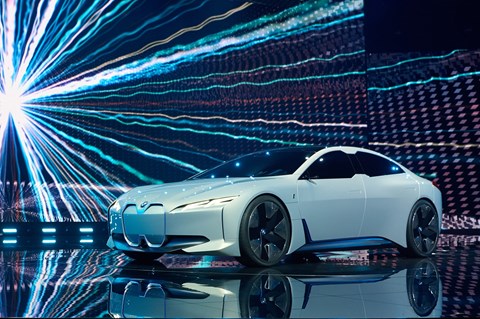
BMW Group’s electric push
If Mercedes had the first word, BMW deserves the last word.
We’re four years from 2021, when the next i crossover is due with enhanced range and Level 4 autonomy. But the i Vision Dynamics concept, a four-door coupe with 370 miles of range pictured above, showed another potential EV bodystyle for the i family.
The 2019 Mini EV concept – to be assembled in the UK – also made an appearance, along with every electrified BMW Group car on the market. There may be questions over the grid and recharging, but BMW is promising to sell 100,000 electrified cars this year alone.
Keep calm and cover all the bases – it’s the story of Frankfurt 2017.
All CAR’s stories from Frankfurt 2017